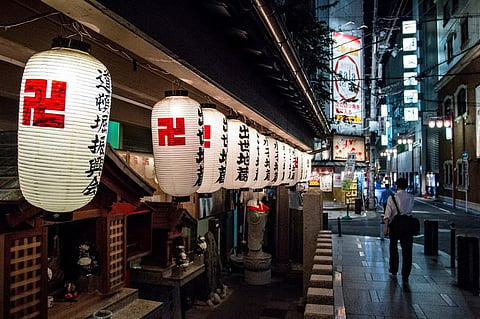
- Home
- न्यूजग्राम
- India
- World
- Politics
- Entertainment
- Culture
- Lifestyle
- Economy
- Sports
- Sp. Coverage
- Misc.
- NewsGram Exclusive
- Jobs / Internships

New Delhi: Japan will soon witness a surging influx of foreign visitors when it will host the Tokyo Olympics in 2020. However, the country is facing the dilemma of whether to identify its Buddhist temples on maps with the 'manji' symbol or not.
Often confused with the Nazi swastika, the symbol hailing from ancient Sanskrit means happiness and prosperity. Usually pointing counter-clockwise (the reverse of the Nazi symbol), the swastika in Japan has been used for centuries in Buddhist decorations, denoting Buddhist temples on maps.
The recommendation was based on survey results collected from more than 1,000 foreigners, including embassy officials, exchange students as well as tourists.
The symbol which has been used for centuries by Hindus and Buddhists has many Western tourists associating it with anti-Semitism and the Holocaust. This was because the emblem was adopted by Nazi Germany in order to enhance their ancient lineage.
In a bid to replace the swastika, a government panel at the Geospatial Information Authority proposed a three-tiered pagoda symbol making it a part of one of the 18 suggested icons for landmarks. Other symbols include hospitals and convenience stores for foreign-language maps as a part of a wider effort to create user-friendly maps for the growing number of foreign tourists.
Public opinion is witnessing an equal say on Twitter and other social networks with supporters attributing the change to bring about an end to the ongoing confusion among tourists and opponents discouraging such change being made for the sake of tourists. Others noted that the symbol of 'manji' is different from the Nazi symbol since it turns the opposite way.
The objective is to make symbols easier to understand, said geospatial authority mapping officer, Takayuki Nakamura.
"A good symbol on the map should be able to tell a visitor what it is at the first glance," he said. "The question is whether one can easily tell it's a temple by looking at the current symbol."
Japan's main Buddhist group is indifferent to the decision. This is because the change is not likely to affect domestic maps and, therefore, won't be altering perceptions in Japan.
Referring to a common term used for the Nazi emblem, Ryoka Nishino, a spokesman for Japan Buddhist Federation said: "We are aware that some people say the 'manji' symbol could remind them of the 'hakenkreuz' symbol, which was created much later in history."
"Even though we have more foreign visitors, our symbol that decorates each temple will stay," he said.
Other symbols that would be altered for foreign maps include the one for a hotel, which currently looks like the symbol for helipads. The current giant X sign supposedly representing a pair of clubs for police station would be replaced by a saluting policeman.
The maps would add a new symbol for convenience stores, which is pervasive all over Japan- a sandwich and water bottle.
A final decision is expected in late March following a period of seeking public comment. (Inputs from gulfnews.com) (Image source: blogspot.com)
